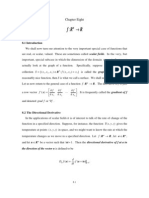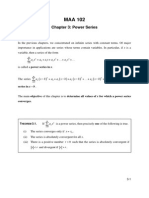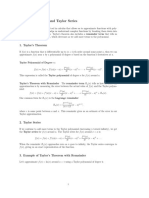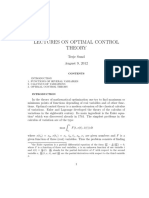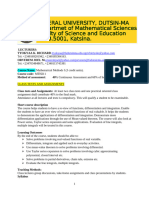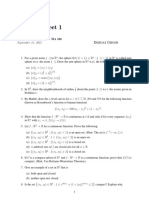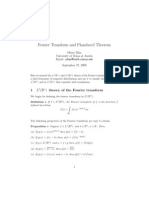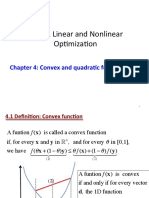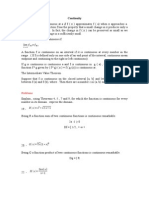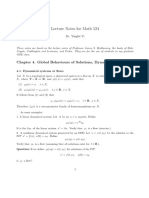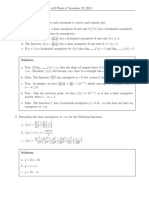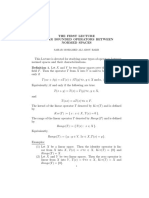Higher Order Derivatives and Taylor Expansions: Example
Higher Order Derivatives and Taylor Expansions: Example
Uploaded by
Norazrizal Aswad Abdul RahmanCopyright:
Available Formats
Higher Order Derivatives and Taylor Expansions: Example
Higher Order Derivatives and Taylor Expansions: Example
Uploaded by
Norazrizal Aswad Abdul RahmanOriginal Title
Copyright
Available Formats
Share this document
Did you find this document useful?
Is this content inappropriate?
Copyright:
Available Formats
Higher Order Derivatives and Taylor Expansions: Example
Higher Order Derivatives and Taylor Expansions: Example
Uploaded by
Norazrizal Aswad Abdul RahmanCopyright:
Available Formats
LECTURE 10
Higher Order Derivatives and Taylor Expansions
1. Higher Order Derivatives
Since a partial derivative of a function f : Rn
makes sense to talk about partial derivatives of partial derivatives; i.e., higher order partial derivatives.
2 f x2 f , f f and f f where f (x, y) = 3x y + x . x x xy x y yx y x
2 2
R is (wherever it exists) again a function from Rn to R it
2 2
Example 10.1. Compute
2f x2
(6xy + 2x) = x = 6y + 2 f x y
f x x
2 f xy
3x2 + 0 = x = 6x f y x
2 f yx
(6xy + 2x) = y = 6x + 0 = 6x
Note that in this example
2 f xy f = yx
2
This is in fact a general phenomenon; the value of a mixed partial derivative does not depend on the order in which the derivatives are taken . Stated more formally;
Theorem 10.2.
then
If
: Rn
is such that all double partial derivatives
2f xi xj
exist and are continous,
2f xi xj
f = x x
j
2. TAYLORS FORMULA FOR FUNCTIONS OF SEVERAL VARIABLES
2. Taylors Formula for Functions of Several Variables
Recall that if f (x) is a function of a single variable that is continuous and dierentiable up to order n + 1 then Taylors theorem says that
f (x) = f (a) + f (a)(x a) +
where the error term 1 2!
f (a)(x a)2 + +
f (n ) (a) n (x a) + Rn (x, a) n!
Rn (x, a)
is given by the formula
Rn (x, a) =
xx a
n!
s f (n+1) (s)ds
and that, moreover, the error term is of order (x a)n+1 . Thus, to order (x a)n we can approximate the function f (x) by the polynomial function
Tn (x) = f (a) + f (a)(x a) +
1 f (a)(x a)2 + + f (n) (a) (x a)n 2! n!
There is an analogous theorem for functions of severa variables. However, since its general statement is a bit messy unless we introduce some new notation, well simply state the rst and second order Taylor formulae
Theorem 10.3.
Let
f : Rn
have continuous partial derivatives up to order
2.
Then we may write
f (x ) = f (a ) +
with the error term
f (a ) (x a ) + R (x , a )
1
R1 (x, a)
going to zero faster that a constant times
as
The rst order Taylor polynomial is the function
T1 (x) = f (a) +
f (a) (x a)
= f (a ) +
f f ( x1 a1 ) + + ( xn a n ) . x1 a xn a
Note that this function is linear in the coordinates of
x.
Its graph is thus a at plane and generalizes the
idea of the best straight line t to a curve : it represents the best at plane approximation to the graph of
f ( x)
near the point
xo .
Theorem
10.4
Let
Rn R have continuous partial derivatives up to order 3.
n i=0
Then we may write
f (x ) = f (a ) +
f ( a ) (x i xi
ai ) + 1 2
i=0 j=0
2f (a) (xi xi xj
a i ) (x j a j ) + R ( x , a )
2
with the error term
R2 (x, a)
going to zero faster that a constant times
as
Example 10.5. Compute the second order Taylor formula for the function f (x, y) = xy + x2 + y2 about the point (1, 1).
2. TAYLORS FORMULA FOR FUNCTIONS OF SEVERAL VARIABLES
We have
f (1, 1) = 1 + 1 + 1 = 3 f y (1,1) f y (1,1)
= (y + 2x + 0)|(1 1) = 3
,
= (x + 0 + 2y)|(1 1) = 3
,
2 f x2 (1,1) 2 f xy (1,1) 2 f y2 (1,1)
= (0 + 2 + 0)|(1 1) = 2
,
2 f yx (1,1)
= (1 + 0 + 0)|(1 1) = 1
, ,
= (0 + 0 + 2)|(1 1) = 2
So 1 +2
+
2 f x2
f (x, y) = f (1, 1) +
f f ( x 1) + (y 1) y (1,1) y (1,1)
(1 ,1)
(x 1)2 +
(1,1)
2f xy
(1 ,1)
(x 1)(y 1)
2 f y2
(1 ,1)
2 f yx
(y 1)(x 1) +
3
(y 1)2
+O
(x, y) (1, 1)
= 3 + 3(x 1) + 3(y 1) + +O
1 2(x 1)2 + 2(x 1)(y 1) + 2(y 1)2 2 (x, y) (1, 1) 3
= 3 + 3(x 1) + 3(y 1) + (x 1)2 + (x 1)(y 1) + (y 1)2 +O (x, y) (1, 1)
3
Below I present another (equivalent) formula for the second order Taylor expansion. Let (x a) be the n-dimensional column vector with components
x a 1 1 x2 a21 (x a ) = ...
xn a n
and let (x a) be the matrix transpose of (x a) (an n-dimensional row vector) (x a)T = (x1 a1 , x2 a2 , , xn an ) . The gradient vector f (a) = Df (a), according to the conventions of Section 2.3 is an n-dimensional row vector;
T
f (a) =
f f (a), f (a), , x ( a) x1 x2 n
2. TAYLORS FORMULA FOR FUNCTIONS OF SEVERAL VARIABLES
Let us now dene the Hessian matrix at the point a as the n n matrix Hf (a) dened by
Hf (a) =
Then we can write 1 f (x) f (a) + f (a) (x a) + (x a)T Hf (a) (x a) + O 2 for the second order Taylor expansion of f about a.
(a ) 2 f x2 x1 (a ) . . . 2 f xn x1 (a )
2f x1 x1
(a) 2 f x2 x2 (a ) .. .
2f x1 x2
2f x1 xn
f xn xn
.. . .. . 2
( a) ( a)
xa
You might also like
- BS 476Document1 pageBS 476Mohamed TahaNo ratings yet
- New Tariff Rate BEDCDocument12 pagesNew Tariff Rate BEDCAsemota OghoghoNo ratings yet
- Optimality Conditions: Unconstrained Optimization: 1.1 Differentiable ProblemsDocument10 pagesOptimality Conditions: Unconstrained Optimization: 1.1 Differentiable ProblemsmaryNo ratings yet
- Taylor SeriesDocument9 pagesTaylor SeriesAbdul Wasiq KhanNo ratings yet
- Control TheoryDocument45 pagesControl TheoryGustavo SánchezNo ratings yet
- Taylor Series NotesDocument5 pagesTaylor Series NotesMR I MacNo ratings yet
- Taylor's TheoremDocument4 pagesTaylor's TheoremTu ShirotaNo ratings yet
- SequnceSeries of FunctionsDocument50 pagesSequnceSeries of FunctionsAlecsandra RusuNo ratings yet
- G(S) L (F (X) ) F (X) e DX: I. Laplace TransformDocument7 pagesG(S) L (F (X) ) F (X) e DX: I. Laplace TransformSnirPianoNo ratings yet
- Ma1505 CheatDocument4 pagesMa1505 CheatSouseiseki ChromeNo ratings yet
- Research On Application of Infinite Series (1st Sem Project)Document26 pagesResearch On Application of Infinite Series (1st Sem Project)Soumyajit BhattacharyaNo ratings yet
- Slides L29Document18 pagesSlides L29clairalexandre510No ratings yet
- Taylor Series: DF (X) DX X ADocument12 pagesTaylor Series: DF (X) DX X ATayyip TahiroğluNo ratings yet
- Cal 8Document17 pagesCal 8Mudit GoelNo ratings yet
- Solutions To Selected Exercises in Chapter TwoDocument31 pagesSolutions To Selected Exercises in Chapter TwoEDU CIPANANo ratings yet
- A Class of Third Order Parabolic Equations With Integral ConditionsDocument7 pagesA Class of Third Order Parabolic Equations With Integral ConditionsArmin SuljićNo ratings yet
- Vector Calculus (1016-410-01) : Plan For The Day - Tuesday 12/4 1 Functions of Several VariablesDocument8 pagesVector Calculus (1016-410-01) : Plan For The Day - Tuesday 12/4 1 Functions of Several VariablesseptemdecillionNo ratings yet
- School of Mathematics and Physics, The University of QueenslandDocument1 pageSchool of Mathematics and Physics, The University of QueenslandVincent LiuNo ratings yet
- Taylor's Theorem in One and Several VariablesDocument4 pagesTaylor's Theorem in One and Several VariablesTu ShirotaNo ratings yet
- Linear Transformations: N M N NDocument15 pagesLinear Transformations: N M N NJose Luis GiriNo ratings yet
- Quadratic Mean Differentiability ExampleDocument5 pagesQuadratic Mean Differentiability ExamplemamurtazaNo ratings yet
- Chapter 3 - Power SeriesDocument19 pagesChapter 3 - Power SeriesAlex TanNo ratings yet
- TaylorDocument5 pagesTaylorpazrieNo ratings yet
- Em 13Document3 pagesEm 13rd317322No ratings yet
- Taylor ExpansionDocument8 pagesTaylor ExpansionJammy4411No ratings yet
- Controltheory PDFDocument45 pagesControltheory PDFFiaz KhanNo ratings yet
- Differentiabilitate I+IIDocument64 pagesDifferentiabilitate I+IIVlad BuldurNo ratings yet
- MTH 211Document39 pagesMTH 211sammyalkasim11No ratings yet
- Chap5--SM4325Document10 pagesChap5--SM4325hilalinaNo ratings yet
- Chapter 4 Differ en Ti Able FunctionsDocument32 pagesChapter 4 Differ en Ti Able FunctionsJeffrey ChuahNo ratings yet
- Lectures On Optimal Control Theory: Terje Sund March 3, 2014Document54 pagesLectures On Optimal Control Theory: Terje Sund March 3, 2014عبدالرحمن الزهرانيNo ratings yet
- On A Functional Equation Characterizing Polynomials of Degree ThreeDocument10 pagesOn A Functional Equation Characterizing Polynomials of Degree Three282523No ratings yet
- Section 11.1: Taylor SeriesDocument8 pagesSection 11.1: Taylor SeriesVns VnsNo ratings yet
- I Mid-Term MathDocument10 pagesI Mid-Term MathkaiisthedodoNo ratings yet
- Problem Sheet 1Document5 pagesProblem Sheet 1Kiran KumarNo ratings yet
- Cobb DouglasDocument14 pagesCobb DouglasRob WolfeNo ratings yet
- Fourier Transform and Plancherel TheoremDocument34 pagesFourier Transform and Plancherel Theoremgogo222No ratings yet
- Module 3 MathsDocument8 pagesModule 3 MathsAnurag JoshiNo ratings yet
- Functions DomainsDocument21 pagesFunctions DomainsEdge of ScenesNo ratings yet
- E1 251 Linear and Nonlinear Op2miza2on: Chapter 4: Convex and Quadra2c Func2onsDocument35 pagesE1 251 Linear and Nonlinear Op2miza2on: Chapter 4: Convex and Quadra2c Func2onsdata scienceNo ratings yet
- CProsolsDocument105 pagesCProsolsK Nirmala AnantapurNo ratings yet
- Continuity: ProblemsDocument5 pagesContinuity: ProblemsjoaquinayzanoaNo ratings yet
- chapter4Document18 pageschapter4tianxu2No ratings yet
- Assignment 2 - Continuity & DifferentiabilityDocument9 pagesAssignment 2 - Continuity & Differentiabilitymohit24031986No ratings yet
- Week10 SmallClass SolutionsDocument8 pagesWeek10 SmallClass SolutionsTang WillaimNo ratings yet
- The First Lecture Linear Bounded Operators Between Normed SpacesDocument9 pagesThe First Lecture Linear Bounded Operators Between Normed SpacesSeif RadwanNo ratings yet
- Second Order Partial Derivatives The Hessian Matrix Minima and MaximaDocument12 pagesSecond Order Partial Derivatives The Hessian Matrix Minima and MaximaSyed Wajahat AliNo ratings yet
- Numerical Methods 1Document10 pagesNumerical Methods 1Sam LockeNo ratings yet
- Week 3Document20 pagesWeek 3Venkat KarthikeyaNo ratings yet
- UPSC Civil Services Main 1985 - Mathematics Calculus: Sunder LalDocument5 pagesUPSC Civil Services Main 1985 - Mathematics Calculus: Sunder Lalsayhigaurav07No ratings yet
- Lesson 4 Derivatives: 1. Derivatives in Multi-Variables FunctionsDocument5 pagesLesson 4 Derivatives: 1. Derivatives in Multi-Variables FunctionsJorge Toran SierraNo ratings yet
- Advanced Calculus FormulasDocument13 pagesAdvanced Calculus Formulasvignes011No ratings yet
- Taylor's Theorem: Harvey Mudd College Math TutorialDocument4 pagesTaylor's Theorem: Harvey Mudd College Math TutorialArtist RecordingNo ratings yet
- Learning Hessian Matrix PDFDocument100 pagesLearning Hessian Matrix PDFSirajus SalekinNo ratings yet
- Prékopa - 1973 - On Logarithmic Concave Measures and FunctionsDocument9 pagesPrékopa - 1973 - On Logarithmic Concave Measures and FunctionsindifferentjNo ratings yet
- Economics 204 Fall 2012 Problem Set 5 Suggested SolutionsDocument8 pagesEconomics 204 Fall 2012 Problem Set 5 Suggested SolutionsFunWithNumbers88No ratings yet
- Math 319 Notes, A.SDocument13 pagesMath 319 Notes, A.SNahitMacitGuntepeNo ratings yet
- Green's Function Estimates for Lattice Schrödinger Operators and ApplicationsFrom EverandGreen's Function Estimates for Lattice Schrödinger Operators and ApplicationsNo ratings yet
- Transformation of Axes (Geometry) Mathematics Question BankFrom EverandTransformation of Axes (Geometry) Mathematics Question BankRating: 3 out of 5 stars3/5 (1)
- Basic Assessment and Basic Care ProceduresDocument31 pagesBasic Assessment and Basic Care Proceduresjanice lopezNo ratings yet
- RZ Inkless DrumDocument1 pageRZ Inkless DrumjrPaRmF6VNpAZiNo ratings yet
- All Weeks (Latest)Document10 pagesAll Weeks (Latest)Hairul AnuarNo ratings yet
- Adidas Ɑdidɑs Since 1949) Is ADocument22 pagesAdidas Ɑdidɑs Since 1949) Is AFountain GirlNo ratings yet
- What Is Hermetically Sealed CompressorDocument2 pagesWhat Is Hermetically Sealed CompressorKaustubh PotnisNo ratings yet
- M 61 FDocument2 pagesM 61 FJaya LoundriNo ratings yet
- Magnetism QRDocument36 pagesMagnetism QRJohn Kevin NocheNo ratings yet
- Fiche Technique FT53027Document1 pageFiche Technique FT53027MateusNo ratings yet
- Zengest OilDocument1 pageZengest OilMarianNo ratings yet
- Eitz Chayim - Tree of Life (Draft)Document7 pagesEitz Chayim - Tree of Life (Draft)Laura Ruach JohnsonNo ratings yet
- History of AppetizerDocument10 pagesHistory of AppetizerErika Therese P. PadillaNo ratings yet
- Seow Koji Takehira 0320816-CompressedDocument23 pagesSeow Koji Takehira 0320816-Compressedapi-302702920No ratings yet
- Intermediate Care Units Recommendations On Facilities and StructureDocument12 pagesIntermediate Care Units Recommendations On Facilities and StructureJHNo ratings yet
- Good Laboratories Practice (GLP) in Pharmaceuticals - PharmaguidelineDocument2 pagesGood Laboratories Practice (GLP) in Pharmaceuticals - PharmaguidelineAhmed GasserNo ratings yet
- The Corpse Washer (Antoon Sinan) (Z-Library)Document174 pagesThe Corpse Washer (Antoon Sinan) (Z-Library)husseinabdulateefzeri4No ratings yet
- Power Generation Manual 1111Document64 pagesPower Generation Manual 1111Mr Khadim HussainNo ratings yet
- Pelton Turbine PDFDocument8 pagesPelton Turbine PDFmanikanthNo ratings yet
- Muntinlupa Ordinance - Underground SystemDocument6 pagesMuntinlupa Ordinance - Underground Systemglenn anayronNo ratings yet
- Sri Isopanisad Self StudyDocument16 pagesSri Isopanisad Self StudyKelisha Moodley100% (2)
- Homework 01 SolutionDocument13 pagesHomework 01 SolutionAxeNo ratings yet
- O&M of HVDC Station - PowerGrid IndiaDocument58 pagesO&M of HVDC Station - PowerGrid IndiaUmamaheshwarrao Varma0% (1)
- Rtu560 CMR02Document4 pagesRtu560 CMR02hemsabhati0% (1)
- Diablo Watch Newsletter, Spring 2004 Save Mount DiabloDocument16 pagesDiablo Watch Newsletter, Spring 2004 Save Mount DiabloMariaqHatziantoniouNo ratings yet
- The Power of TenDocument2 pagesThe Power of TenRabbi Benyomin HoffmanNo ratings yet
- Cover PageDocument4 pagesCover Pageg tsNo ratings yet
- PDE677 Serrature RevolutionPRO ENDocument12 pagesPDE677 Serrature RevolutionPRO ENMarco PauloNo ratings yet
- Rapporto Sul Mercato Cinese Delle Macchine Tessili: April 2011Document64 pagesRapporto Sul Mercato Cinese Delle Macchine Tessili: April 2011DI DINo ratings yet
- Chapter10 Flight Control SystemDocument11 pagesChapter10 Flight Control SystemmsrchandNo ratings yet













